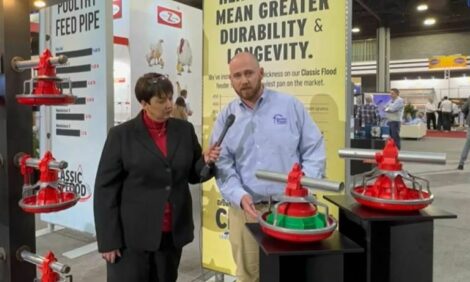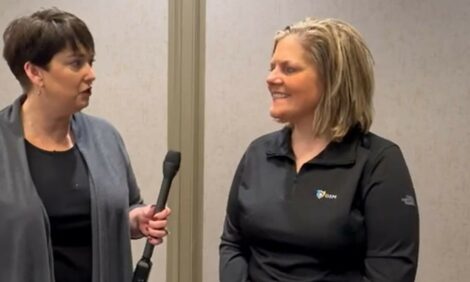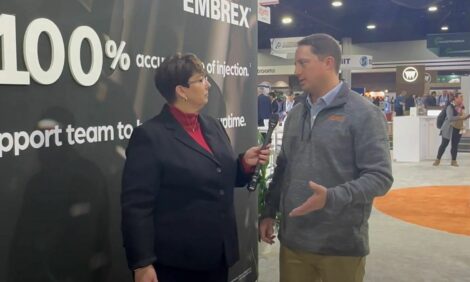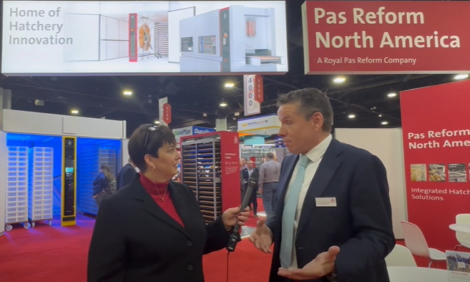



HATCH for Hunger expanding, feeding the new face of hunger
US egg, chicken, pork and beef producers - learn how you can get involvedPart of Series:
< Previous Article in Series Next Article in Series >
Danny Leckie, Executive Director of HATCH for Hunger recently spoke to Global Ag Media’s Sarah Mikesell at the 2023 International Production & Progress Expo (IPPE) annual conference in Atlanta, Georgia, USA.
HATCH for Hunger feeds the needy
“HATCH for Hunger was founded in 2015,” Said Leckie. “It was based on this idea, farmers who put food on the shelves of grocery stores could also put food on the shelves of foodbanks and food pantries.”
HATCH for Hunger works with producers to improve and increase access to animal proteins for those in need.
“This idea of animal proteins can help change lives is the passion behind our program,” he said.
The program has expanded due to the increased need by providing eggs to food pantries to building food banks to satisfy the need.
“Over the last year, HATCH for Hunger has grown from 11 food banks in 12 states to 54 food banks in 21 states,” said Leckie.
HATCH for Hunger is filling a gap and a need in food bank networks.
“Every day we have the privilege and opportunity to increase access to proteins to those who may not be able to afford it for themselves,” he said. “HATCH helps the industry provide these animal proteins to those in need no matter what their circumstances.”
Changing face of hunger
“The face of hunger are changing,” Leckie said. “It's not what it used to be 20 to 30 years ago. The new faces of hunger are the single working parent, and the parents who are working multiple jobs to make ends meet for their children.”
With today’s increase in food prices, people are buying food, but it's not the right kind of food. It may be what they can afford, and healthier foods tend to be higher priced, he said.
“HATCH for Hunger can help provide the right kinds of food to those families, so those children's bellies feel fuller,” said Leckie. “It also can help homebound, elderly adults who can't go to a grocery store, receive food.”
The program allows people who need some assistance to feel dignified and human and it provides an opportunity to get the calories and the nourishment that they need. Eggs are a powerhouse of nutrition with 13 essential vitamins, minerals and antioxidants. An egg provides half the protein requirement for a child each day.
“HATCH for Hunger continues to grow and evolve because of the increased number of food banks, food pantries, and producers that are aligned with the program,” said Leckie. “These alliances are working together to bring protein to all people on a larger scale.”
Expansion of services
“In 2015 when HATCH for Hunger was founded, we were delivering 5,000 dozen eggs a month,” said Leckie. “If you fast forward to 2019, the number of eggs per month was about 80,000 dozen eggs.”
In 2022, on average, HATCH for Hunger delivered 300,000 dozen eggs a month. So the program has grown tremendously and continues to expand its opportunities across the US delivering proteins.
“In 2022, 5.1 million dozen eggs were delivered to food banks and food pantries in a year that was faced with challenges,” said Leckie. “This represents 30 million two-egg meals.”
This boost in growth happened while the poultry industry faced COVID, highly pathogenic avian influenza (HPAI), runaway inflation, carton shortages, box shortages and other challenges, he said.
“But the heart of the industry continued to shine through all the adversity and provided support, despite the circumstances,” he explained.
The HATH for Hunger producers maintained the egg supply because they believe in the program.
“We pivoted to purchasing eggs, which was a really big change for the HATCH for Hunger model,” said Leckie.
“The program worked off a shared-value model to help create value throughout the entire chain - from the producer to the food bank to the community.”
Animal protein delivered to communities can create a generational change that can provide a lasting impact on people's eating habits and lives.
Sustainability of program - Eggs for the Greater Good
“We've maintained a sustainable model, because of long-standing partnerships and relationships with organizations that support and share our beliefs and mission.”
As a result of the increased demand of the working poor, the lines at food pantries were longer in 2022 than they were during COVID, so the industry producers stepped up, sacrificing profits, to fulfill the mission and to help feed people.
“Farmers do what farmers do best - feeding people regardless of the circumstances,” said Leckie. “HATCH for Hunger is grateful for that continued commitment. The program continues to grow across of all the US.”
“In 2022, we went from a regional non-profit to a national non-profit in the course of eight months,” he said. “It was a tremendous transition for the program.”
US producers can get involved in the movement
“Producers can get involved with HATCH for Hunger, by visiting www.hatchforhunger.com,” said Leckie.
Producers can talk to any of the more than 12 producers who currently partner with HATCH for Hunger, egg brokers and other organizations who are familiar with the benefits of the program.
“It is very important to continue to share information and find sustainable solutions for ending hunger. We believe bringing food security to this country through animal protein is a way to connect people through education,” he said.
People working together in their communities to advocate for their residents can accomplish a lot for local food pantries and food banks. It is important for people to engage in finding solutions to problems such as hunger.
“HATCH for Hunger is not the only organization that can make a difference, but we would like to work within a community to make sure strategic giving is implemented,” said Leckie.
HATCH for Hunger has a sustainable model that will determine the need and create equitable access across the entire system.
Delivering additional proteins
“Since we're now in 21 states, that map growth is helping the program to expand into distributing new proteins,” said Leckie.
The long-term goal is to sustainably deliver 100 million protein-rich meals to hunger relief organizations by 2025.
The demand and need for the distribution of proteins are genuine and HATCH for Hunger has been contacted by local food banks who are impressed with what they can do with egg protein distribution.
“The protein delivery program can be expanded beyond just eggs, to include chicken, turkey, beef, pork, and dairy,” Leckie said. “HATCH for Hunger wants to work to provide these much-needed proteins as well.”
“We're a strategic-giving vehicle for the industry producers to provide resources to meet the needs,” said Leckie. “It’s a testament to the industry and their belief in what HATCH for Hunger is doing and their core belief in the need to feed people.”














